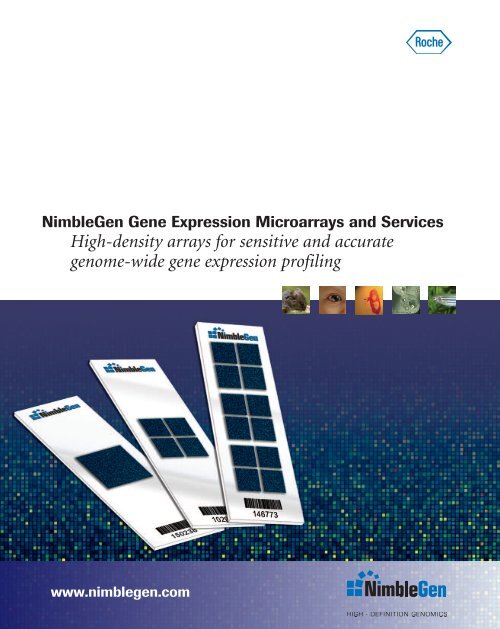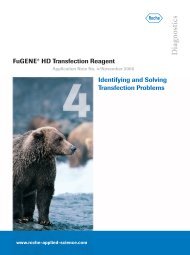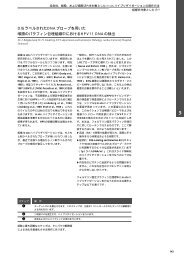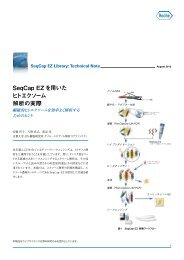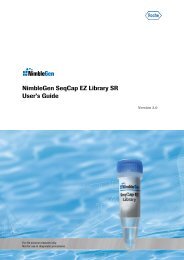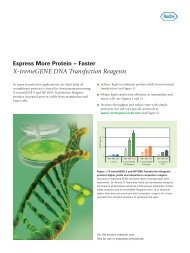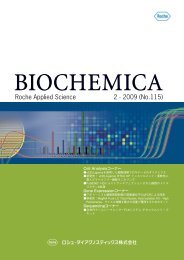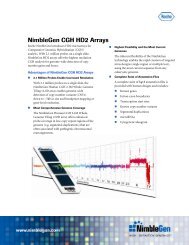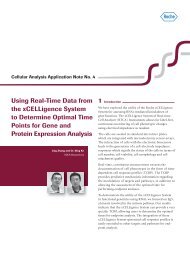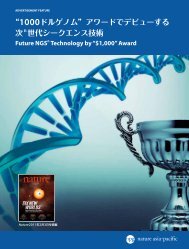Gene Expression
Gene Expression
Gene Expression
Create successful ePaper yourself
Turn your PDF publications into a flip-book with our unique Google optimized e-Paper software.
NimbleGen <strong>Gene</strong> <strong>Expression</strong> Microarrays and Services<br />
High-density arrays for sensitive and accurate<br />
genome-wide gene expression profiling<br />
www.nimblegen.com
Roche NimbleGen offers a comprehensive catalog of gene expression arrays for<br />
whole-genome expression profiling. With the unique combination of long<br />
oligonucleotide probes, flexible array content, and high probe density (up to<br />
385,000 probes per array), NimbleGen <strong>Gene</strong> <strong>Expression</strong> arrays enable easy-to-use<br />
and cost-effective analysis of eukaryotic and prokaryotic genomes. Built on the<br />
ultra-high density HD2 platform, the 12x135K array format combines a<br />
multiplex option with high probe density for high-throughput projects.<br />
_________________________ Advantages ______________________________________________________3<br />
_________________________ Protocol _________________________________________________________4<br />
_________________________ Performance Data ______________________________________________5-7<br />
_________________________ Formats and Design Specifications ________________________________8<br />
_________________________ Access Options __________________________________________________9<br />
_________________________ Applications and References _____________________________________10<br />
2 |
Advantages of NimbleGen <strong>Gene</strong> <strong>Expression</strong> Microarrays<br />
High-density arrays for high-throughput analysis<br />
More Probes per Transcript<br />
The ultra-high density of NimbleGen DNA<br />
microarrays allows every gene to be represented by<br />
multiple, unique probes on a single array. The signal<br />
averaging of multiple probes provides improved<br />
statistical confidence, reducing the impact of<br />
inconsistent probe behavior and improving the signal<br />
accuracy compared to platforms that offer fewer<br />
probes per gene.<br />
Long Oligos Enhance Accuracy<br />
Roche NimbleGen has the ability to synthesize highdensity<br />
arrays of long oligos. For gene expression<br />
analysis, long oligos (45 - 60mer) provide excellent<br />
signal-to-noise ratio, sensitivity, specificity, and<br />
discrimination, particularly in complex eukaryotic<br />
genomes. Long probes eliminate the need for<br />
mismatch probes, effectively doubling array capacity.<br />
Multiplex Options: Cost-Effective,<br />
High-throughput Analysis<br />
Roche NimbleGen multiplex arrays enable you to<br />
analyze multiple samples in parallel. We offer a 4x72K<br />
format with 72,000 probes per array and a 12x135K<br />
format with 135,000 probes per array. Hybridize four<br />
or 12 samples or run replicate samples on a single<br />
slide and average the data for increased statistical<br />
confidence.<br />
Up-to-date Microarray Design<br />
Roche NimbleGen’s digital microarray manufacturing<br />
process is fast and flexible, allowing you rapid access to<br />
any sequenced genome on an array. All catalog designs<br />
are built from the latest published genomes to ensure<br />
your experiment is current.<br />
High-interarray Reproducibility<br />
NimbleGen arrays are manufactured to exacting<br />
standards and undergo rigorous quality control to<br />
ensure superior interarrray reproducibility. In replicate<br />
hybridization experiments, interarray r 2 values<br />
routinely exceed 0.98.<br />
Flexible Access Options to Best Suit<br />
Your Needs<br />
Roche NimbleGen offers options for both full service<br />
analysis or array delivery for hybridization in your own<br />
lab. Choose to send your RNA or cDNA samples to us<br />
for processing in our full-service laboratory or<br />
hybridize your samples and analyze the data in your lab<br />
using our protocols and reagents.<br />
What users are saying about NimbleGen<br />
<strong>Gene</strong> <strong>Expression</strong> 12x135K Arrays:<br />
“Use of the NimbleGen 12x135K gene expression<br />
microarray is advantageous and more accurate than<br />
other platforms because it allows you to run replicates<br />
within the same array that validate analysis within<br />
the same experiment. Also, conducting the array<br />
hybridization is relatively straightforward, and<br />
analysis of the results is user-friendly and does not<br />
require highly specialized informatics skills.”<br />
Licia Selleri, MD, PhD, Associate Professor<br />
Departments of Cell and Developmental Biology<br />
Cornell University Medical School, New York<br />
Advantages<br />
| 3
NimbleGen <strong>Gene</strong> <strong>Expression</strong> Protocol<br />
Four easy steps from RNA to differentially expressed genes<br />
A<br />
B<br />
NimbleGen <strong>Gene</strong> <strong>Expression</strong> arrays are provided with<br />
fully supported, validated protocols – from sample<br />
preparation through data analysis.<br />
Protocol<br />
1 1<br />
⊳ Figure 1: <strong>Gene</strong> <strong>Expression</strong> Analysis Protocol<br />
Contact Roche Microarray Technical Support for complete protocol details.<br />
1. cDNA Synthesis: Eukaryotic (A) or prokaryotic mRNA (B) is converted<br />
via oligo-dT or random priming, respectively, to double-stranded cDNA.<br />
2. cDNA Labeling: The cDNA is labeled with Cy3 dye.<br />
3. Hybridization: Labeled cDNA is hybridized to a NimbleGen <strong>Gene</strong><br />
<strong>Expression</strong> array.<br />
4. Data Analysis: Data are extracted using NimbleScan software and<br />
analyzed for differentially expressed genes.<br />
2<br />
3<br />
4<br />
1 2 3 4 5 6<br />
Hierarchical<br />
Clustering<br />
Universal Human<br />
Reference RNA<br />
Human Brain<br />
Reference RNA<br />
Low <strong>Expression</strong> High<br />
4 |<br />
<br />
Figure 2: Sensitive and Reproducible Detection of <strong>Gene</strong><br />
<strong>Expression</strong> Levels. Two human RNA samples used in the<br />
Microarray Quality Consortium 1 project were analyzed on the<br />
NimbleGen Human <strong>Gene</strong> <strong>Expression</strong> 385K array. <strong>Gene</strong>s exhibiting<br />
an 8-fold or higher change between Universal Human Reference<br />
RNA (lanes 1 - 3) and Human Brain Reference RNA (lanes 4 – 6)<br />
were analyzed by hierarchical clustering analysis (far left column)<br />
and plotted as a heat map using the ArrayStar ® software<br />
(DNASTAR, Inc). Orange bars indicate high expression values<br />
while purple bars indicate low expression values.
NimbleGen <strong>Gene</strong> <strong>Expression</strong> Performance Data<br />
Accurate, sensitive, and reproducible gene expression profiling<br />
The high quality of NimbleGen <strong>Gene</strong> <strong>Expression</strong><br />
microarrays was proven using the MAQC reference<br />
samples (Universal Human Reference RNA [Stratagene]<br />
and Human Brain Reference RNA [Ambion] 1 ) on highdensity<br />
NimbleGen Human <strong>Gene</strong> <strong>Expression</strong> 385K,<br />
4x72K, and 12x135K arrays.<br />
The accuracy of NimbleGen microarray data was<br />
assessed by comparing the fold change values from the<br />
microarrays to the values obtained by COBAS ®<br />
TaqMan ® quantitative PCR assays 1<br />
(Figure 3). Each<br />
point on the scatter plot represents the fold change level<br />
of a gene; a total of 961 genes detected in both the<br />
TaqMan ® assay and NimbleGen array were included in<br />
the analysis. NimbleGen single and multiplex arrays<br />
demonstrate high concordance with TaqMan ® results<br />
and were consistent in correlation with results from<br />
other commercial microarray platforms (Table 1).<br />
<br />
Figure 3: Accuracy. The ratio of brain to universal<br />
expression values (log 2<br />
) from NimbleGen Human<br />
<strong>Gene</strong> <strong>Expression</strong> 12x135K microarrays were<br />
compared to TaqMan ® data obtained from the MAQC<br />
report. Results show a high concordance (r = 0.92) in<br />
gene expression levels between NimbleGen<br />
microarray and TaqMan ® data.<br />
Performance<br />
Data<br />
Array Correlation with COBAS ® TaqMan ®<br />
NimbleGen 12x135K 0.92<br />
NimbleGen 4x72K 0.92<br />
NimbleGen 385K 0.91<br />
Affymetrix 0.92*<br />
Applied Biosystems 0.85*<br />
Agilent 0.91*<br />
Illumina 0.91*<br />
⊳<br />
Table 1: High-Quality Data Obtained with<br />
NimbleGen <strong>Gene</strong> <strong>Expression</strong> Arrays. Log 2<br />
-ratios of<br />
brain RNA to universal RNA gene expression levels<br />
from microarrays from the indicated sources were<br />
compared to the same ratio from TaqMan ® analysis.<br />
*Mean for three test sites, as published by the MAQC Consortium 1 .<br />
1<br />
Nat. Biotechnol. 2006; 24(9: 1151-1161)<br />
| 5
NimbleGen <strong>Gene</strong> <strong>Expression</strong> 12x135K Performance Data<br />
Cost-effective, high-throughput whole-genome gene expression profiling<br />
NimbleGen 12x135K microarrays for gene expression<br />
analysis enable you to conveniently and simultaneously<br />
hybridize 12 samples on each slide. These multiplex<br />
arrays offer a cost-effective approach to gene expression<br />
analysis, without compromising information content or<br />
data quality. As with our 385K and 4x72K arrays,<br />
12x135K arrays are available in a broad range of wholegenome<br />
catalog designs or custom design arrays tailored<br />
to your specific experimental goals.<br />
Performance<br />
Data<br />
Advantages<br />
Accurately analyze 12 samples simultaneously on a<br />
single slide.<br />
Achieve high specificity, sensitivity, and reproducibility<br />
with 60mer oligonucleotide probes.<br />
Utilize 135,000 features on each array to include<br />
multiple probes per target:<br />
• Complete coverage of a transcriptome<br />
• Increased accuracy with multiple probes per target<br />
Take advantage of catalog designs based on the most<br />
current whole-genome builds for a variety of<br />
organisms.<br />
Customize array content for any available, annotated<br />
genome.<br />
<br />
Figure 5: Reproducibility. Six technical replicates of human brain<br />
RNA were hybridized to NimbleGen Human <strong>Gene</strong> <strong>Expression</strong><br />
12x135K microarrays. High interarray correlations (mean r 2 = 0.99)<br />
are shown in the lower-left panels, and pairwise scatter plots of<br />
gene expression values (log 2<br />
) are shown in the upper-right panels.<br />
<br />
Figure 4: Sensitivity. Human brain and universal RNA were<br />
analyzed on NimbleGen Human <strong>Gene</strong> <strong>Expression</strong> 12x135K<br />
microarrays (4 technical replicates per sample). High sensitivity<br />
is demonstrated by the wide dynamic range (log 2<br />
of 4 - 16) of<br />
gene expression values on each array.<br />
6 10 14 6 10 14 6 10 14<br />
A01<br />
0.986<br />
6 10 14 6 10 14 6 10 14<br />
A02<br />
0.989 0.988<br />
A03<br />
0.991 0.985 0.987<br />
A04<br />
0.992 0.986 0.987 0.992<br />
A05<br />
0.990 0.986 0.988 0.990 0.992<br />
6 10 14 6 10 14 6 10 14<br />
A06<br />
6 10 14 6 10 14 6 10 14<br />
6 |
NimbleGen <strong>Gene</strong> <strong>Expression</strong> Prokaryotic Performance Data<br />
Extensive line of microbial multiplex catalog designs<br />
Prokaryotic <strong>Gene</strong> <strong>Expression</strong> Analysis<br />
Roche NimbleGen offers high density arrays for<br />
over 200 Class I, II, and III prokaryotic organisms<br />
in 385K and 4x72K array formats. Because each<br />
385K array contains up to 385,000 features, there is<br />
sufficient probe capacity to tailor an existing array<br />
design to address specific research questions.<br />
Consider including:<br />
Relevant plasmids<br />
Probes from intergenic regions<br />
Probes from multiple organisms<br />
Your own custom controls<br />
NimbleGen 4x72K microarrays for prokaryotic<br />
gene expression analysis enable you to conveniently<br />
and simultaneously hybridize four independent<br />
samples on each slide. These multiplex arrays offer<br />
a cost-effective approach to gene expression<br />
analysis. Similar to our 385K prokaryotic arrays,<br />
these arrays are available in a broad range of wholegenome<br />
catalog or custom designs tailored to your<br />
specific experimental goals.<br />
<br />
Figure 6: Sensitivity of NimbleGen E. coli <strong>Gene</strong><br />
<strong>Expression</strong> 4x72K Microarrays. The pairwise scatter plot of<br />
gene expression values (log 2<br />
) for wild type and mutant E. coli<br />
RNA correctly identifies 22 transcripts encoded by genes that<br />
are present in the wild type strain but deleted in the mutant<br />
strain (blue box). The number of genes (and as percent of<br />
total genes) differentially expressed at 2-, 4-, or 8-fold are<br />
indicated in the upper left.<br />
Performance<br />
Data<br />
| 7
NimbleGen <strong>Gene</strong> <strong>Expression</strong> Format and Design Specifications<br />
Choice of catalog and custom eukaryotic and prokaryotic<br />
designs for processing in your lab or ours<br />
Catalog Designs<br />
Eukaryotic <strong>Gene</strong> <strong>Expression</strong> Arrays<br />
Roche NimbleGen offers a broad range of catalog<br />
eukaryotic arrays for the latest genome builds for human<br />
and the model organisms listed below. Eukaryotic arrays<br />
are available in both single (385K) and multiplex (4x72K<br />
and 12x135K) formats, allowing for both genome-wide<br />
probe coverage and high-throughput analysis.<br />
Custom Designs<br />
For organisms not listed in the NimbleGen product catalog,<br />
custom designed arrays are available for any organism with<br />
high-quality sequence and annotation information. Arrays<br />
can also be customized for your focused region or control<br />
genes (such as probes for spike-ins of known transcripts as<br />
positive controls). Provide us with the target sequences, we<br />
will design the probes and synthesize the arrays.<br />
• Human<br />
• Mouse<br />
• Rat<br />
• Zebrafish<br />
• A. thaliana<br />
• C. elegans<br />
• D. melanogaster<br />
• S. cerevisiae<br />
• S. pombe<br />
385K Array<br />
4x72K Array<br />
12x135K Array<br />
Format and<br />
Design<br />
Specifications<br />
Prokaryotic <strong>Gene</strong> <strong>Expression</strong> Arrays<br />
Roche NimbleGen offers the most comprehensive set of<br />
prokaryotic gene expression designs in the industry,<br />
covering over two hundred Class I, II, and III organisms,<br />
including B. subtilis, E. coli, S. enterica, and Y. pestis. Our<br />
high-density arrays allow for every gene in a prokaryotic<br />
genome to be represented by up to 20 unique transcriptspecific<br />
probes and 5 replicate probe sets, depending on<br />
the size of the genome, on a single array, thereby<br />
improving statistical confidence in your results.<br />
Alternatively, simultaneously analyze four samples on a<br />
single 4x72K array for increased throughput without<br />
compromising information content or data quality.<br />
Additionally, there is sufficient probe capacity on each<br />
array to tailor an existing design to address specific<br />
research questions, such as including probes from relevant<br />
plasmids, multiple organisms, or your own custom<br />
controls.<br />
<strong>Gene</strong> <strong>Expression</strong> Microarray Formats and Specifications<br />
Format 385K 4x72K 12x135K<br />
Total Probes 385,000 4 x 72,000 12 x 135,000<br />
Probe length (bases) Eukaryote: 60 Eukaryote: 60 Eukaryote: 60<br />
Prokaryote: 45 - 60 Prokaryote: 45 - 60 NA †<br />
Probes per target gene* Eukaryote: 6 - 20 Eukaryote: 2 - 7 Eukaryote: 3 - 7<br />
(catalog designs) Prokaryote: 12 - 25 Prokaryote: 6 - 17 NA †<br />
Replicate probe sets* Eukaryote: 1 - 4 Eukaryote: 1 Eukaryote: 1 - 2<br />
(catalog designs) Prokaryote: 3 - 5 Prokaryote: 2 - 3 NA †<br />
Feature size 16µm x 16µm 16µm x 16µm 13µm x 13µm<br />
Array size 17.4mm x 13.0mm 7.8mm x 5.7mm 8.9mm x 6.5mm<br />
Slide size<br />
1” x 3” (25mm x 76mm)<br />
* Depending on genome size<br />
†<br />
Not Available<br />
8 |
NimbleGen <strong>Gene</strong> <strong>Expression</strong> Access Options<br />
<strong>Gene</strong> <strong>Expression</strong> arrays available for array delivery or full service<br />
Array Delivery Workflow<br />
1. Select a catalog gene expression array design or work<br />
with Roche NimbleGen Bioinformatics team to create a<br />
custom array.<br />
2. Roche NimbleGen manufactures the array and ships it<br />
to your laboratory.<br />
3. Prepare cDNA samples using the Roche NimbleGen<br />
validated protocol, label and hybridize to the array.<br />
4. Scan array and extract data using NimbleScan software.<br />
5. Identify differentially expressed genes using appropriate<br />
software for expression analysis.<br />
Full Service Workflow<br />
1. Select a catalog gene expression array design or work with<br />
the Roche NimbleGen Bioinformatics team to create a<br />
custom array.<br />
2. Prepare RNA or cDNA samples using validated NimbleGen<br />
protocol and ship them to Roche NimbleGen.<br />
3. Roche NimbleGen manufactures the array and performs<br />
hybridization and data analysis.<br />
4. Roche NimbleGen ships the following:<br />
• Array design files<br />
• Raw gene expression data<br />
• RMA-normalized gene expression data<br />
5. Identify differentially expressed genes using appropriate<br />
software for expression analysis.<br />
Delivery<br />
Select a catalog<br />
design or create<br />
a custom design<br />
Roche<br />
NimbleGen<br />
manufactures<br />
array<br />
Roche<br />
NimbleGen<br />
ships array<br />
to customer<br />
Synthesize<br />
and label<br />
cDNA<br />
Hybridize<br />
sample<br />
Wash<br />
array<br />
Scan<br />
array<br />
Analyze<br />
data<br />
Required Instruments & Kits<br />
Required Kits & Accessories<br />
Required Instruments<br />
Required Software<br />
Service<br />
NimbleGen Hybridization System<br />
NimbleGen Hybridization Kit<br />
NimbleGen Sample Tracking<br />
Control Kit (for multiplex arrays)<br />
NimbleGen Wash Buffer Kit<br />
NimbleGen Array Processing<br />
Accessories<br />
Microarray Scanner<br />
NimbleScan<br />
Access<br />
Options<br />
Select a catalog<br />
design or create<br />
a custom design<br />
Ship samples<br />
to Roche<br />
NimbleGen<br />
Roche<br />
NimbleGen<br />
manufactures<br />
array<br />
Synthesize<br />
and label<br />
cDNA<br />
Hybridize<br />
sample<br />
Wash<br />
array<br />
Scan<br />
array<br />
Roche NimbleGen<br />
performs data<br />
analysis and ships<br />
data to customer<br />
Roche NimbleGen<br />
Customer<br />
| 9<br />
| 9
NimbleGen <strong>Gene</strong> <strong>Expression</strong> Applications and References<br />
Take advantage of the inherent flexibility, sensitivity, and<br />
discrimination provided by NimbleGen <strong>Gene</strong> <strong>Expression</strong><br />
microarrays for numerous applications<br />
Applications<br />
Differential <strong>Expression</strong><br />
Study gene expression related to multiple signal pathways in<br />
tissues and cells.<br />
Identify factors involved in plant tissue differentiation.<br />
Discover regulatory targets for an orphan two-component<br />
signal regulator and virulence factor in Streptococcus<br />
pneumoniae.<br />
Assess differential gene expression of closely related<br />
protozoan parasites.<br />
References<br />
Batista F, et al. “Potential targets of FOXL2, a transcription factor involved in<br />
craniofacial and follicular development, identified by transcriptomics,” Proc.<br />
Natl. Acad. Sci. USA: 104:3330 (2007).<br />
Pischke M, et al. “A Transcriptome-Based Characterization of Habituation in<br />
Plant Tissue Culture,” Plant Physiol.: 140:1255 (2006).<br />
Motegi M, et al. “Assessment of <strong>Gene</strong>s Associated with Streptococcus mutans<br />
Biofilm Morphology,” Appl. Environ. Microbiol.: 72: 6277 (2006)<br />
Ulijasz A, et al. “Regulation of Iron Transport in Streptococcus pneumoniae by<br />
RitR, an Orphan Response Regulator,” J Bacteriol.: 186:8123 (2004).<br />
Study different but closely related protozoan parasites using a<br />
single expression microarray design.<br />
Tiled <strong>Expression</strong><br />
Register the non-coding RNAs in human fibroblasts and yeast.<br />
Identify novel transcripts in rice or Populus trichocarpa.<br />
Catalog global gene expression in Homo sapiens, Drosophila<br />
melanogaster, Chlamydomonas reinhardtii, Arabidopsis thaliana,<br />
or rice.<br />
Confirm bioinformatically identified genes using expression<br />
profiling.<br />
Catalog the global gene expression in rice.<br />
Holzer T, et al. “<strong>Expression</strong> profiling by whole-genome interspecies microarray<br />
hybridization reveals differential gene expression in procyclic promastigotes,<br />
lesion-derived amastigotes, and axenic amastigotes in Leishmania Mexicana,”<br />
Mol. Biochem. Parasitol. 146:198 (2006).<br />
Rinn J, et al. “Functional Demarcation of Active and Silent Chromatin<br />
Domains in Human HOX Loci by Non-coding RNAs,” Cell: 129:1311 (2007).<br />
Samanta M, et al. “Global identification of noncoding RNAs in Saccharomyces<br />
cerevisiae by modulating an essential RNA processing pathway,” Proc. Natl<br />
Acad. Sci. USA: 103:4192 (2006).<br />
Rinaldi C, et al. “Transcript Profiling of Poplar Leaves upon Infection with<br />
Compatible and Incompatible Strains of the Foliar Rust Melampsora laricipopulina,”<br />
Plant Physiol: 144:347 (2007).<br />
Tuskan G, et al. “The genome of black cottonwood, Populus trichocarpa (Torr.<br />
& Gray),” Science: 313:1596 (2006).<br />
Li L, et al. “Genome-wide transcription analyses in rice using tiling<br />
microarrays,” Genome Biol.: 6:R52 (2005).<br />
Allele-Specific <strong>Expression</strong><br />
Identify allele-specific expression in the cotton genome.<br />
Udall J, et al. “A Novel Approach for Characterizing <strong>Expression</strong> Levels of<br />
<strong>Gene</strong>s Duplicated by Polyploidy,” <strong>Gene</strong>tics: 173:1 (2006).<br />
Applications<br />
and<br />
References<br />
10 |
NimbleGen Products and Services for High-Definition Genomics<br />
NimbleGen Arrays and Services<br />
Roche NimbleGen offers two options to fit your schedule,<br />
budget, and focus: order arrays to perform experiments in<br />
your own lab or send us sample and let us perform the<br />
experiment for you. Applications include:<br />
CGH (Comparative Genomic Hybridization)<br />
Measure DNA copy number differences between a test and<br />
reference genome.<br />
ChIP-chip (Chromatin Immunoprecipitation-on-chip)<br />
Measure transcription regulation, the histone code,<br />
polymerase activity, or any DNA-protein binding.<br />
DNA Methylation<br />
Correlate promoter and genic DNA methylation with gene<br />
expression and compare differential methylation between cells,<br />
tissues, and other research samples, such as tumor samples.<br />
<strong>Gene</strong> <strong>Expression</strong><br />
Profile genome-wide gene expression patterns to study<br />
effects of treatments or causes of variations in eukaryotic<br />
or prokaryotic organisms.<br />
Sequence Capture<br />
Enrich large regions or thousands of loci from complex<br />
genomic DNA in preparation for high-throughput sequencing.<br />
Custom Arrays<br />
Accelerate your development of new and cutting-edge<br />
scientific applications.<br />
Instruments<br />
Increase throughput while achieving high quality,<br />
reproducible results.<br />
Kits<br />
Simplify the experimental process with prepackaged<br />
reagents and validated protocols.<br />
Software<br />
Facilitate the research pipeline from array design to image<br />
extraction to data analysis with our suite of software.<br />
Training<br />
Receive detailed instruction in both the theory and<br />
practice of genomic and epigenomic research techniques<br />
at our customer workshops, at our facility or yours.
NIMBLEGEN, COBAS, and TAQMAN are trademarks of Roche.<br />
Other brands or product names are trademarks of their respective holders.<br />
For life science research only.<br />
© 2008 Roche NimbleGen, Inc. All Rights Reserved<br />
Roche NimbleGen, Inc.<br />
504 S. Rosa Road<br />
Madison, WI 53719 USA<br />
05227739001 • 11/08<br />
www.nimblegen.com<br />
www.nimblegen.com


